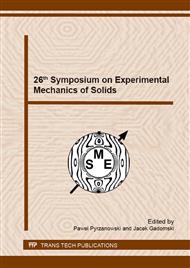p.191
p.198
p.206
p.212
p.218
p.225
p.232
p.238
p.244
Influence of the Parameter of Ductility of Reinforcing Steel on the Behaviour of a Narrow Three-Span Reinforced Concrete Slab Based on Experimental Investigations
Abstract:
In the time of the exploitation of building structures frequently situations do occur, in which due to failures they are exposed to much higher loads than has been originally predicted. In a state of emergency due to overloading of the structure, significant reserves of load capacity may be appear in the case of a self-acting tension member work. The aim of the paper was to demonstrate the influence of reinforced steel parameters and its quantity on the mechanism of destruction of four three-span models of reinforced concrete strips with the dimensions 7140×500×190 mm. The paper contains the description of the test stand and test models and the results of experimental tests which were compared with the results of the calculations based on traditional methods.
Info:
Periodical:
Pages:
218-224
Citation:
Online since:
August 2015
Authors:
Price:
Сopyright:
© 2016 Trans Tech Publications Ltd. All Rights Reserved
Share:
Citation:


